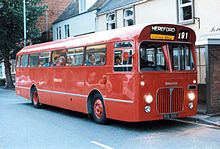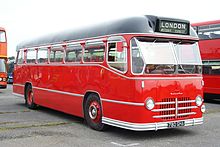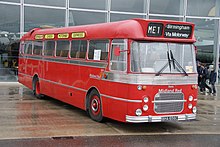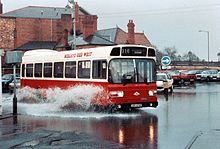 Preserved BMMO S22s Preserved BMMO S22s | |
| Founded | July 1905 |
|---|---|
| Ceased operation | 5 September 1981 |
| Headquarters | Edgbaston |
| Service area | The Midlands |
| Service type | Bus operator Bus manufacturer |
| Depots | 23 (September 1981) |
| Fleet | 838 (September 1981) |
Midland Red was a bus company that operated in The Midlands from 1905 until 1981. It was one of the largest English bus companies, operating over a large area between Gloucester in the south and Derbyshire in the north, and from Northampton to the Welsh border. The company also manufactured buses.
History






Origins
In 1899 the British Electric Traction (BET) company acquired the assets of the Birmingham General Omnibus Company, which had been formed three years earlier to acquire a number of horse bus operations in Birmingham. When BET ordered new buses for Birmingham the next year, they were painted red to make them stand out. In 1902 BET acquired the City of Birmingham Tramways Company, which operated horse buses as well as trams.
The Birmingham & Midland Motor Omnibus Company (BMMO) was formed by local businessmen in November 1904 to operate motor bus services in Birmingham. When the directors failed to attract sufficient investors, BET acquired control of the new company, and in 1905 transferred its local horse bus operations to it. The company also acquired a motor bus company which had started in 1903. BMMO started operations under its own name in July 1905. However, the company experienced problems with its motor buses, and in 1907 reverted all its motor bus services to horse bus operation.
In 1912 the company purchased some Tilling-Stevens petrol-electric buses. Further motor buses followed, and by June 1913 only 17 horse buses remained. The company adopted for its motor buses the red livery used by Birmingham General, and the buses carried the fleetname "Midland". They soon acquired the nickname Midland Red.
Expansion outside Birmingham
By 1912 the Birmingham Corporation Tramways had used its statutory powers to acquire the city's tramways which it did not already own, and wanted to consolidate the operation of bus and tram operations in the city. Since it was going to be difficult for BMMO to expand in the city, it reached agreement with the corporation to operate services from outside Birmingham into the city and transfer its services within the city to the corporation. The company then expanded outside Birmingham, and moved its headquarters to Bearwood in Smethwick.
During World War I, the company took over BET operations in Worcester and elsewhere, and after the war opened depots in Walsall, Coventry, Wolverhampton, Hereford, Stafford, Banbury, Bromsgrove, Shrewsbury, Nuneaton, Leamington Spa and Leicester. During the 1920s the tramways owned by BET in the Black Country were gradually replaced by Midland Red buses.
In 1930, the Great Western Railway and the London Midland & Scottish Railway together acquired 50% of the company. The few GWR bus services in the area were transferred to Midland Red.
Coach services
Midland Red started express coach services in 1921 with routes to Weston-super-Mare and Llandudno. Coach services expanded, and in 1934 Midland Red became a founder member of the Associated Motorways consortium.
Coach services were heavily reduced during World War II, but expanded again after the war. When the M1 motorway opened in 1959, Midland Red started non-stop express services between Birmingham and London, and later between Coventry and London. For the service, the company developed Britain's first high-speed motor-coach. A fleet of ten, capable of speeds of up to 85 miles per hour (140 km/h), were built at the company's workshops at Edgbaston. The opening of the M5 motorway enabled the operation of express services between Birmingham and Worcester.
Nationalisation
When the railways were nationalised forming in 1947 under the Transport Act 1947, Midland Red became 50% state-owned. In 1968, BET sold its UK bus interests to the government, and on 1 January 1969 the company became the largest subsidiary of the National Bus Company (NBC). The livery was later changed from a deep red to the NBC corporate poppy red.
In 1973 the garages (with the exception of Digbeth Coach Station, Bearwood and Cradley Heath) and routes within the West Midlands county were transferred to the control of the West Midlands Passenger Transport Authority, leaving Midland Red with country and local routes mainly in Derbyshire, Herefordshire, Leicestershire, Nottinghamshire, Shropshire, Staffordshire, Warwickshire and Worcestershire and express services.
Rebranding
From 1977 onwards, after extensive passenger research the company was rebranded into local area names under the Viable Network Project, something that was soon renamed as the Market Analysis Project and widely adopted throughout NBC and elsewhere in the bus industry. Each new network spawned a localised brand, as follows:
- Avonbus: Stratford-upon-Avon
- Chaserider: Cannock & Stafford
- Hotspur: Shrewsbury & Ludlow
- Hunter: Nuneaton & Hinckley
- Lancer: Coalville & Swadlincote
- Leamington & Warwick: Leamington Spa
- Leicester: Leicester (did not carry area branding names)
- Mercian: Tamworth & Lichfield
- Reddibus: Redditch
- Ridercross: Banbury & Kineton
- Rugby Midland Red: Rugby
- Severnlink: Worcester, Malvern & Bromsgrove
- Tellus: Telford
- Wendaway: Kidderminster
- Wayfarer: Evesham
- Wandaward: Hereford
- Midland Express: long-distance and limited stop services
Breakup

On 6 September 1981, Midland Red was split into six new companies:
- Midland Red East, renamed Midland Fox in January 1984: Leicestershire, south Derbyshire and east Staffordshire (the Lancer and Leicester operations)
- Midland Red North: Shropshire, south Staffordshire, and northern West Midlands (the Chaserider, Hotspur, Mercian and Tellus operations)
- Midland Red South: Warwickshire and north Oxfordshire (the Avonbus, Hunter, Leamington & Warwick, Ridercross and Rugby operations)
- Midland Red West Herefordshire, Worcestershire, south and east quadrants of West Midlands (the Reddibus, Severnlink, Wandaward, Wayfarer and Wendaway operations)
- Midland Red Express, later renamed Midland Red Coaches: central coach and express services division, became part of Midland Red West in 1984
- Midland Red Engineering, later renamed Carlyle Works: central engineering workshops at Carlyle Road, Edgbaston
Privatisation
As part of the privatisation of the National Bus Company, the companies were sold:
- Midland Fox, formerly Midland Red East, was sold on 18 August 1987 in a management buyout. The operations of the Swadlincote depot were purchased by Stevensons of Uttoxeter. Today all have been reunited as part of Arriva Fox County. It is a division of Arriva Midlands.
- Midland Red North was sold on 27 January 1988 to the Drawlane Transport Group. It was included in the sale of Drawlane to British Bus which in turn became part of the Cowie Group. Today it is part of Arriva Midlands.
- Midland Red South was sold on 10 December 1987 to Western Travel Limited who also owned the Cheltenham & Gloucester Omnibus Company. Today it is part of Stagecoach West and Stagecoach Midlands. Midland Red (South) Ltd. is the legal name for Stagecoach Midlands.
- Midland Red West was sold on 22 December 1986 in a management buyout led by managing director Ken Mills to Midland West Holdings It who also took over Midland Red Coaches on the same date. Today it is part of First Midland Red but only has one surviving depot in Worcester. The Kidderminster and Redditch operations were sold to Rotala while the company withdrew from operating in Hereford.
- Carlyle Works, formerly Midland Red Engineering, was sold to Frontsource Limited, who also purchased the engineering divisions of an initial eight and later nine National Bus Companies. It closed in October 1991.
Bus manufacture
In 1912 the company bought its first Tilling-Stevens petrol-electric vehicles. Tilling-Stevens became the main supplier of bus chassis to the company which, under its Chief Engineer LG Wyndham Shire, adapted and developed the designs to its own requirements, finally designing a vehicle it intended to construct itself.
Between 1923 and 1969, the BMMO built most of the buses it operated: up to 1940 these were called SOS (rumoured to stand for Superior Omnibus Specification), and some models were supplied to other bus companies associated within the British Electric Traction (BET) group, namely Trent, PMT and Northern General. After 1940, the vehicles were identified by the company's initials, BMMO, and supplied solely for the BMMO company's own use. Codes later used for buses were FEDD (Front Entrance Double Decker), REDD (Rear Entrance Double Decker), Coaches were initially classified "ONC", but later used a prefix of "C" – or "CM" for Motorway coaches.
Single Decker models after the war were numbered S6, then S8 through S23, Double Decker models D1 through D10. The D10 was, in some opinions, the pinnacle of BMMO bus design – a double decker with front entrance/rear exit and an underfloor engine, but only two were produced. AD2, GD6 and LD8 were exceptions to the normal designation system – these codes referred to batches of respectively AEC, Guy and Leyland vehicles acquired when the manufacturing operation could not meet the heavy demand. Individual buses were numbered from (around) 2000 to 5900 – registrations (usually) incorporated the last three numbers of the serial, and a letter prefix of three letters ending in "HA" ( a Smethwick origin registration mark). This relationship did not apply to the limited number of buses gained as a result of acquisition of other operators.
Bus manufacture, overhaul and accident repair was carried out at Carlyle Works, adjacent to the Rotton Park Reservoir in Edgbaston, Birmingham. Nearby to the works was BMMO's head office, in Vernon Road, Edgbaston.
Historical list of Midland Red garages
- Banbury, Canal Street –
- Bearwood, Bearwood Road – (Closed 1973) –
- Birmingham, Digbeth Coach Station – . Used by Midland Red West for West Midlands PTE area routes.
- Birmingham, Sheepcote Street, Five Ways (Passed to WMPTE) – (Closed 1975) –
- Birmingham, Tennant Street (Passed to Birmingham Corporation 1914)
- Bishops Castle, Midland Red West outstation
- Brierley Hill, Dudley Road , (passed to WMPTE) – (Closed 1993) – . Later demolished after use by furniture company. former tram depot
- Bromsgrove, The Strand, Birmingham Road – (Closed 1981) –
- Cannock, Delta Way. The last depot opened by Midland Red. Became Head office for Midland Red North (later Arriva Midlands North). Sold to D&G Bus t/a 'Chaserider' autumn 2020.
- Coalville, Ashby Road – (Closed 2011) –
- Cradley Heath, Forge Lane – (Closed 1977) – . Building now used for commercial purposes.
- Dudley, Birmingham Road (passed to WMPTE) – (Closed 1993) – . Demolished for Dudley Southern By-pass. former tram depot
- Evesham, Abbey Road – (Closed 2006) –
- Heath Hayes, Hednesford Road (formerly Harper Brothers) – (Closed 1977)
- Hereford, Friar Street – (Closed 2015) – . Operations now in hands of independent bus operators.
- Hinckley, Lower Coventry Road – (Closed 1979) –
- Kidderminster, KDL&T depot (now Tram Road) former tram depot
- Kidderminster, New Road – (Closed 2001) – . Operations in Kidderminster sold to Diamond Bus in 2013.
- Kineton, Brookhampton Road (formerly Stratford Blue)
- Leamington Spa, Old Warwick Road – (Closed 1980) –
- Leamington Spa, Myton Road – (Closed 1991)
- Leicester, Southgate Street – (Closed 2009) –
- Leicester, Sandacre Street – (Closed 1996) –
- Lichfield, Trent Valley Road (used by Staffordshire County Highways Dept) –
- Ludlow, Weeping Cross Lane – (Closed 1983) –
- Malvern, Portland Road – (Closed 1954)
- Malvern Link, Spring Lane – (Closed 1976) –
- Market Harborough, formerly N&S – (Closed 2005)
- Markfield, Shaw Lane, (formerly Brown's Blue Coaches Ltd) – (Closed 1968)
- Nuneaton, Coton Road – (Closed 1960)
- Nuneaton, Newtown Road –
- Oldbury, Birchley Crossing (passed to WMPTE) – (Closed 1975) – .
- Redditch, Church Road – (Closed 2004) – . Operations and replacement depot sold to Diamond Bus in 2013.
- Rugby, Railway Terrace –
- Shrewsbury, Ditherington – (Closed 2012) – . Passed to Arriva Midlands. Site sold to Shrewsbury Council for redevelopment.
- Stourbridge, Foster Street (passed to WMPTE) – (Closed 1985) – . Demolished and replaced by car dealership.
- Stafford, Pilgrim Place, Newport Road – (Closed 1992) –
- Stratford-upon-Avon, Warwick Road (formerly Stratford Blue) – (Closed 1990). Now a commercial tyre depot.
- Sutton Coldfield, Upper Holland Road (passed to WMPTE) – (Closed 1984) – . Demolished and replaced by housing development.
- Swadlincote, Midland Road – (Demolished 2010) – . Replaced by Old Railway Mews housing development.
- Tamworth, Watling Street, Twogates (Reliant works) – . Replaced by The Garage housing development.
- Tamworth, Aldergate
- Warwick, Emscote Road (formerly L&WT Co Ltd) – (Closed 1957)
- Wellington, Charlton Street – (Closed 2012) – . Replaced by new Arriva Midlands depot in Stafford Park, Telford.
- Wigston, Station Street, South Wigston –
- Wolverhampton, Bilston Street – (Closed 1964). Located opposite since demolished former Wolverhampton Corporation (later West Midlands Travel) depot.
- Wolverhampton, Dudley Road – (Closed 1971) – . Used by bus operator Travel Express Ltd, which operates as Let's Go.
- Worcester, East Street –
- Worcester, Padmore Street
Other short time-span garages (either owned or rented) included: Birmingham, Ladywood Road (Five Ways Inn yard); Coventry, Sandy Lane; Cradley, (GWR station yard); Halesowen, Mucklow Hill (GWR station yard); Hereford, Bridge Street (Black Lion Yard); Kingswinford, The Portway; Leicester, Frog Island; Leicester, Hastings Road; Leicester, Welford Road; Nuneaton, Burgage Walk (ex NWMO&T Co); Nuneaton, Heath End Road; Nuneaton, the former Empire theatre; Sedgley, WDET Co depot; Shrewsbury, Abbey foregate (ex Allen Omnibus Co); Shrewsbury, Roushill; Stafford, Co-operative Street; Wellington, Mansell Street.
Timeline
- 1904: Formation of BMMO.
- 1905: First services.
- 1914–1920: Rapid spread of services outside Birmingham to 'Paint the Midlands Red'.
- 1920s: Development of long-distance coach routes using charabancs.
- 1923: First production run of BMMO buses, SOS 'S' type – one of the first British buses to have pneumatic tyres.
- 1927: 'QL' type bus produced, the first Midland Red bus design to have brakes on all wheels.
- 1930s: Development of petrol and diesel engines. Experimental rear-engined buses built.
- 1940s: Experiments with, and production of under-floor engined single-deck buses.
- 1950s: Experiments and developments of integral construction, independent front suspension, air suspension, rubber suspension, glass fibre construction and disc brakes.
- 1958: Introduction of the D9, a new half-cab double deck design incorporating most of the successful features developed in the 1950s.
- 1959: The introduction of the CM5T, a turbocharged coach capable of almost 100 mph, for non-stop motorway services. The Birmingham-London express coach service launched on 2 November – the same day that the M1 motorway was opened. CM5T designation indicated by 'M' high speed (Motorway) capability and by 'T' fitted with passenger toilet facilities.
- 1960: Appearance of the first of the two experimental D10 double-deckers, with under-floor engines.
- 1963: One of the country's first fully enclosed city centre bus stations was opened at Birmingham's Bull Ring Shopping Centre, from which most Midland Red services in the City Centre departed.
- 1960s: Larger motorway coach introduced, the CM6T between 1963–6. Midland Red becomes the first British bus company to make wide-scale use of computers in compiling bus schedules and staff rosters.
- 1970s: Winding down of vehicle production. Last Midland Red built-bus (S23 single-decker no. 5991) produced in 1970. Split up of the operating area – West Midlands PTE take the West Midlands Metropolitan area garages.
- 1980s: Midland Red split into five operating companies and an engineering company. Leading to privatisation by buy-outs.
- 1990s: Take over by the current conglomerate transport groups.
See also
References
- ^ Companies House extract company no 82681 Midland Red Omnibus Company Limited formerly Birmingham & Midland Motor Omnibus Company Limited
- ^ Birmingham and Midland Motor Omnibus Company (Midland Red) Made in Birmingham
- ^ Sixty Years of Midland Red Commercial Motor 27 November 1964
- Midland Red Get Motorway Services Commercial Motor 27 March 1959
- Coventry-London services along M1 Commercial Motor 9 September 1960
- "85-m.p.h. Coach for motorway". The Guardian. 3 September 1959. p. 1. Retrieved 25 January 2019. – via newspapers.com (subscription required)
- PTA to get Red services Commercial Motor 1 December 1972
- The Reds regroup Commercial Motor 11 April 1981
- Companies House extract company no 1556557 Foxhound Limited formerly Midland Fox Limited formerly Midland Red (East) Limited
- Bold NBC move Commercial Motor 21 January 1984
- Companies House extract company no 1556305 Arriva Midlands North Limited formerly Midland Rd (North) Limited
- Companies House extract company no 1556310 Midland Red (South) Limited
- Companies House extract company no 1556327 First Midland Red Buses Limited formerly Midland Red West Limited
- Companies House extract company no 1556325 Bristol Bus Station Limited formerly Midland Red Coaches Limited formerly Midland Red (Express) Limited
- Another NBC shake-up Commercial Motor 21 April 1984
- Companies House extract company no 213817 Frontsource (1) Limited formerly Carlyle Works Limited
- ^ History – Midlands Arriva
- News Commercial Motor 25 February 1988
- 6m payment renews fat-cat row The Independent 27 November 1995
- Cowie Group plc and British Bus Group Limited: A report on the merger situation Competition Commission 31 October 1996
- Companies House extract company no 2041677 Stagecoach West Limited formerly Western Travel Limited
- Companies House extract company no 2059633 FirstBus Group Limited formerly FirstGroup Holdings Limited formerly Midland Red West Holdings Limited
- NBC sells more Commercial Motor 10 January 1987
- Companies House extract company no 2059335 Frontsource Limited
- Buyer sought for failed Carlyle Commercial Motor 22 October 1991
- "Midland Red depot information".
Further reading
- Anderson, R.C. A History of The Midland Red. Newton Abbot: David and Charles (1984).
- Gray, P. Midland Red (Vol.1) – A history of the company and its vehicles up to 1940. Glossop: Transport Publishing Company (1978).
- Gray, P. Midland Red (Vol.2) – A history of the company and its vehicles from 1940–1970. Glossop: Transport Publishing Company (1979).
- Greenwood, M. The Heyday of Midland Red. Hersham: Ian Allan (2005).
- Keeley, M. Midland Red. London: Ian Allan (1983).
- Keeley, M. Midland Red – Working Days. Hersham: Ian Allan, in conjunction with the Transport Museum, Wythall (2008).
- Richards, S. More Room on Top – Midland Red: The BMMO D9 and D10. Steve Richards (2012).
- Torode, R. and Keeley, M. Midland Red Style. London: Capital Transport (2011).
External links
 Media related to Midland Red at Wikimedia Commons
Media related to Midland Red at Wikimedia Commons- Flickr gallery
- MidlandRed.net
- Large collection of preserved Midland Red buses and coaches Transport Museum, Wythall
- Black Country Living Museum - owner of preserved BMMO D9 bus, fleet number 5342
- Companies based in Smethwick
- Defunct bus manufacturers of the United Kingdom
- Former nationalised industries of the United Kingdom
- 1905 establishments in England
- 1981 disestablishments in England
- Former bus operators in the West Midlands (county)
- Former bus operators in Herefordshire
- Former bus operators in Staffordshire
- Former bus operators in Oxfordshire
- Former bus operators in Worcestershire
- Former bus operators in Shropshire
- Former bus operators in Leicestershire
- Former bus operators in Nottinghamshire



